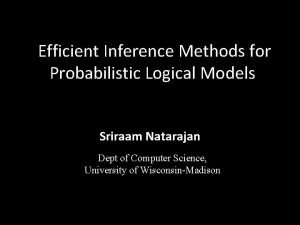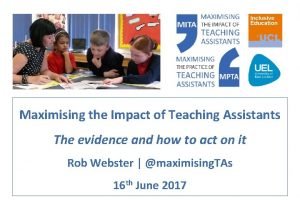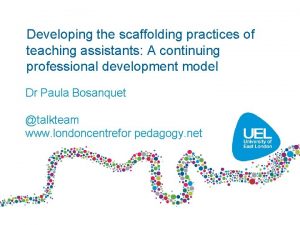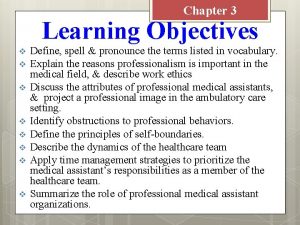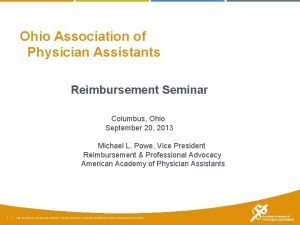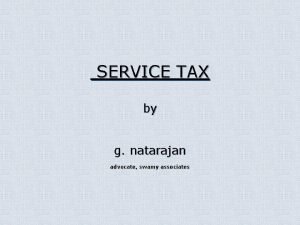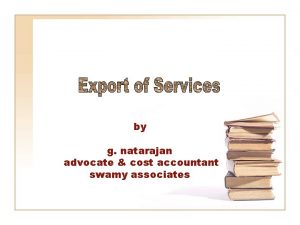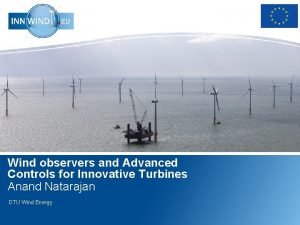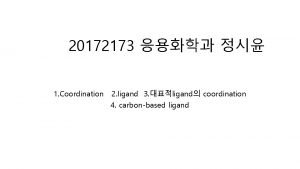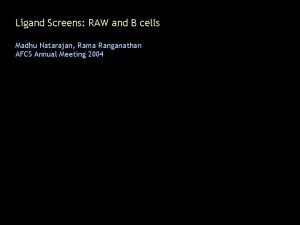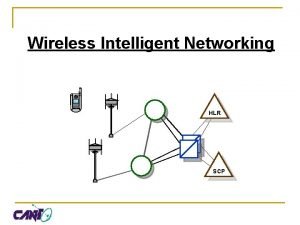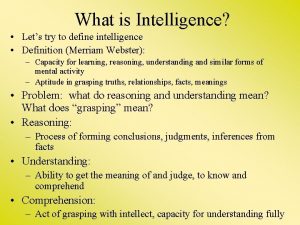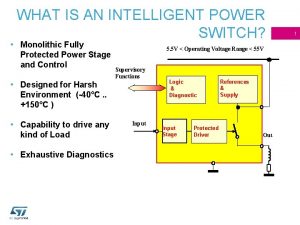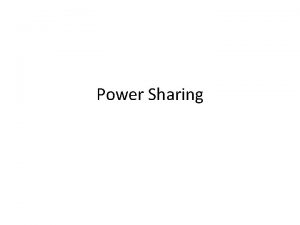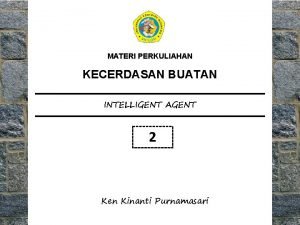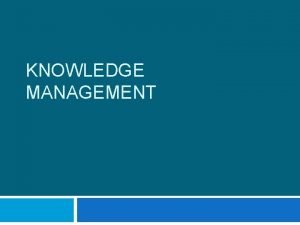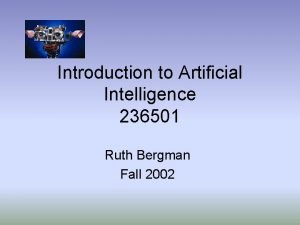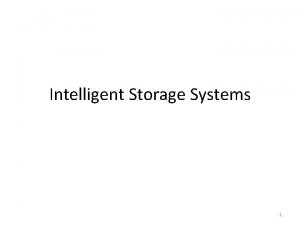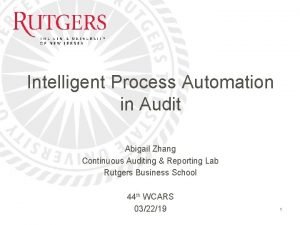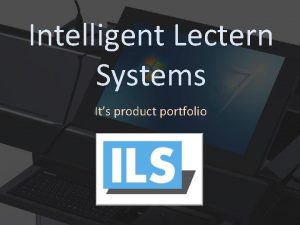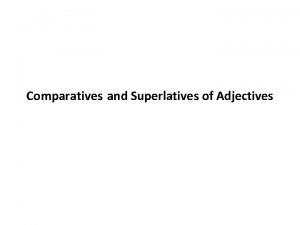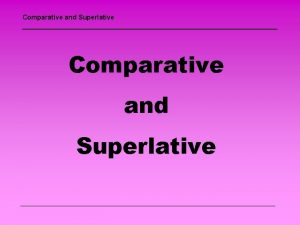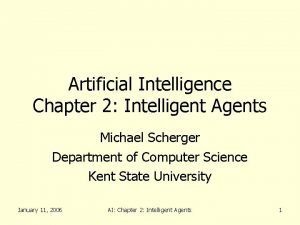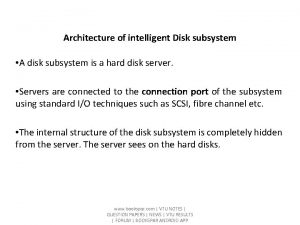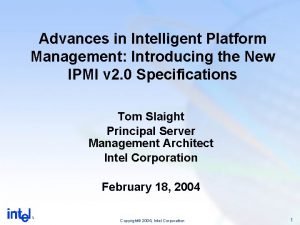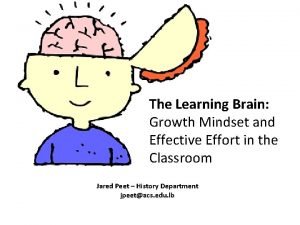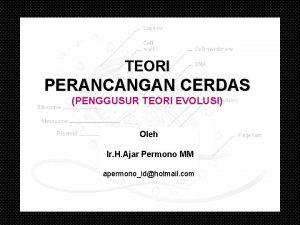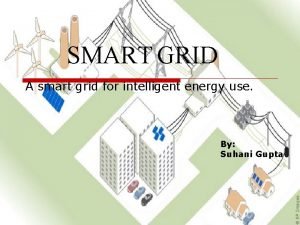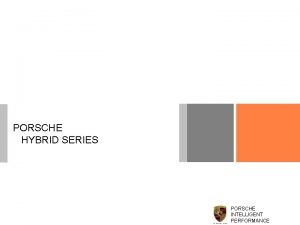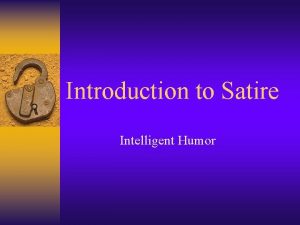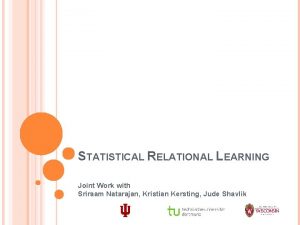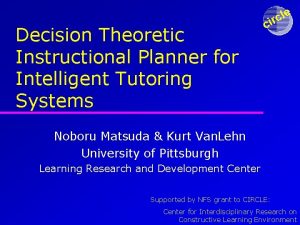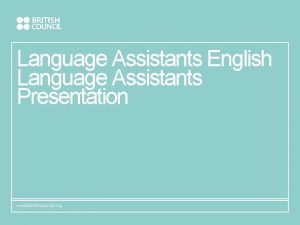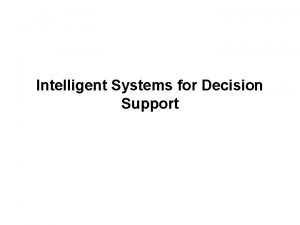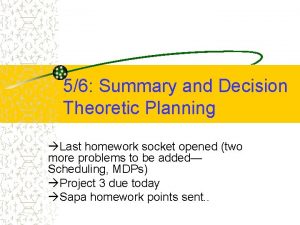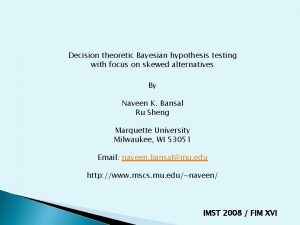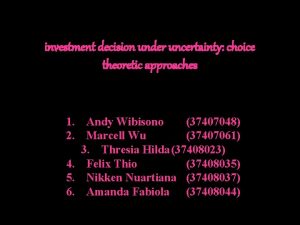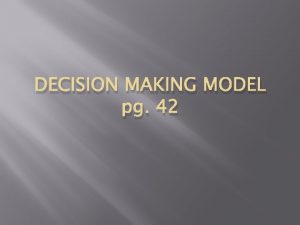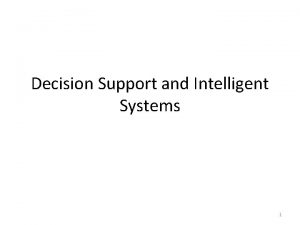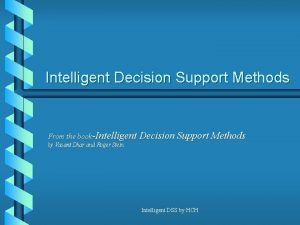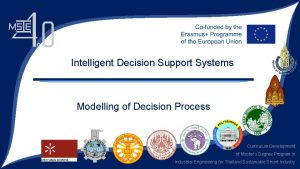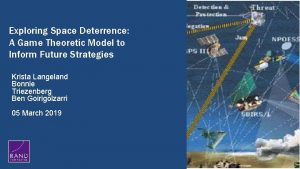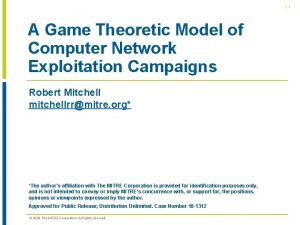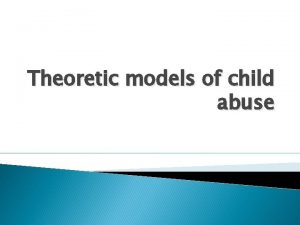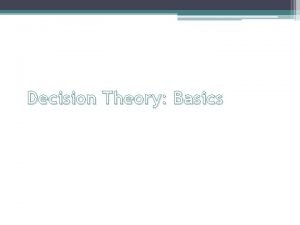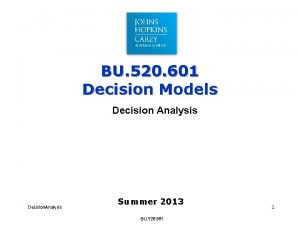Intelligent Assistants A Decision Theoretic Model Sriraam Natarajan











































- Slides: 43

Intelligent Assistants - A Decision. Theoretic Model Sriraam Natarajan * Joint work with Prasad Tadepalli, Alan Fern, Kshitij Judah School of EECS, Oregon state University * Currently at AIC, SRI International

Motivation § Several assistant systems proposed to § § Assist users in daily tasks Reduce their cognitive load § Examples: CALO (CALO 2003), COACH (Boger et al. 2005), Electric Elves (Varakantham et al. 2005) etc § Problems with previous work § § § Fine-tuned to particular application domains Utilize specialized technologies Lack an overarching framework

Goals n Decision-theoretic model n n n Problems with the model n n n General notion of assistance Evaluate on a real world domain – Folder predictor Rationality Assumption Flat user goals Relational Hierarchical Model n n n Remove the assumption Augment with prior knowledge Combines ideas from decision-theory, logical models and probabilistic methods

Outline Decision-Theoretic Model of Assistance n Experiments – Folder Predictor n Incorporating Relational Hierarchies n Experiments n Conclusion n

Interaction Model Goal Action set U User Action W 1 Initial State W 2 Action set A Assistant

Interaction Model Minimize user’s cost User Assistant User Action W 1 Initial State W 2 W 3 W 4 Assistant Actions W 5

Interaction Model Goal User Assistant User Action W 1 Initial State W 2 W 3 W 4 Assistant Actions W 5 W 6

Intelligent Assistant I have a clearer idea User Assistant User Action W 1 Initial State W 2 W 3 W 4 Assistant Actions W 5 W 6 W 7 W 8

Intelligent Assistant Wow!!! That was quick User Assistant User Action W 1 Initial State W 2 W 3 W 4 Assistant Actions W 5 W 6 W 7 W 8 W 9 Goal Achieved

World and User Models G Ut Goal Distribution P(G) Action distribution conditioned on goal and world state P(Ut | G, Wt) Transition Model At Wt+1 P(Wt+1 | Wt, Ut, At) Wt U 1 W 1 Given: model, action sequence U 2 W 3 A 1 W 4 Output: assistant action

Reinforcement Learning n n RL is useful in domains with no teacher/supervision Trail and error interactions by the agent The agent obtains reinforcements for its actions The agent uses the reinforcements to learn how to behave Actions Percepts Rewards/Penalties World (Environment)

Markov Decision Process An MDP is described by: n n n A set of states, S A set of action, A A reward function rimm(s, a) A state transition function P(s’|s, a) Current State is independent of the past Policy (p ( ) – Mapping from states to actions V(p) = E(ΣTt=1 rt), T = length of episode A Partially Observable Markov Decision Process (POMDP): n n § § O is the set of observations µ(o|s) is a distribution over observations o є O given current state s

Decision-Theoretic Model (Fern et al. 07) § Assistant: History-dependent stochastic policy p‘(a|w, O) § Observables: World states, Agent’s actions § Hidden: Agent’s goals § Episode begins at state w with goal g § C(w, g, p, p’): Cost of episode § Objective: compute p’ that minimizes E[C(I, G 0, p, p’)]

General Assistant POMDP Goal G State Wt+1 Wt User Action Observatio n At A’t At+1 Ot Asst Action A’t+1

Approximate Solution Approach n Online action selection cycle 1) Estimate posterior goal distribution given observation 2) Select best action for the goal distribution using myopic heuristics Goal Recognizer P(G) Action Selection Assistant Wt Ot At Environment Ut User

Goal Estimation n Given n P(G | Ot) : Goal posterior at time t P(Ut | G, Wt) : User policy Ot+1 : New observation of user action and world state must learn user policy new observation Goal posterior given observations up to time t P(G | Ot) Updated goal posterior Ut Wt Current State Wt+1 P(G | Ot+1)

Action Selection: Assistant POMDP n Assume we know the user goal G and policy n n Can create a corresponding assistant MDP over assistant actions Can compute Q(A, W, G) giving value of taking assistive action A when users goal is G Assistant MDP G At’ Wt n At’ U Wt+1 Wt+2 Wt P Select action that maximizes (myopic) value: = P expected (G j Ot )Q(A , W ) ; W; G) G Wt+2

Decision-Theoretic Model n Experiments – Folder Predictor n Incorporating Relational Hierarchies n Experiments n Conclusion n


Folder Predictor n Previous work (Bao et al. 2006): n n n Decision-Theoretic Model n n n No repredictions Does not consider new folders Naturally handles repredictions Considers mixture density to obtain the distribution P(f ) = ¹ 0 P 0 (f ) + (1 ¡ ¹ 0 )Pl (f ) Data set – set of requests of Open and save. As Folder hierarchy – 226 folders Prior distribution initialized according to the model of Bao et al.

all folders considered 1. 319 restricted folder set 1. 3724 1. 2344 Full Assistant Framework 1. 34 Current Tasktracer No Reprediction With Repredictions Avg. no. of clicks per open/save. As

Decision-Theoretic Model n Experiments – Folder Predictor n Incorporating Relational Hierarchies n Experiments n Conclusion n

Motivation – Early Assistance n Models need to be specified for early assistance n Assumption - User is “nearly rational” n Assumption – Flat user policy: Unreasonable in many domains n Goal: Remove assumptions by using Relational Hierarchical Goal structure n Goal structure and probabilistic relationships serve as prior knowledge

World and User Models Flat! G Specify this distribution Ut Goal Distribution P(G) Action distribution conditioned on goal and world state P(Ut | G, Wt) Transition Model At Wt+1 P(Wt+1 | Wt, Ut, At) Wt U 1 W 1 Given: model, action sequence U 2 W 3 A 1 W 4 Output: assistant action

Goal: Biasing the Assistant with Prior Knowledge n Initialize the assistant with hierarchical relational task knowledge Relational Hierarchical Prior Knowledge Goal Recognizer P(G) Action Selection Assistant Wt Ot At Environment Ut User

Prior Knowledge – Hierarchical Goal Structure Write Paper Abstract Main Paper Write Section Run Exp Compile Results Send to Peers Draw Figures Email Attach

Prior Knowledge – Relational Structure n Several tasks have a similar structure n n n Humans exploit this similarity n n Use the templates and the methodology from one conference for another Influence relationships exist between task parameters n n n Papers to ICML or IJCAI have the same structure Conference trip plans have the same structure The urgency of the paper depends on its deadline The reviewing potential of a person depends on his expertise Idea n n Explicitly represent the relationships between the objects Use ideas from SRL to represent the influence statements

Doorman Domain

ROOT Gather(R) Attack(E) R. Type = S. Type Collect(R) E. Type = D. Type Deposit(R, S) Kill. Dragon(D) Destroy. Camp(E) L = S. Loc Drop. Off(R, S) L = R. Loc Pickup(R) L = E. Loc L = D. Loc Goto(L) Move(X) Kill(D) Destroy(E) Relational Task Atom Open(D) Primitive

Conditional Influences – Soft constraints Depends. On(Subgoal(Deposit(R, S) , Distance(Loc(S), Loc(R))) ← Available(Deposit(R, S)) “The choice of R and S of the current Deposit subgoal depends on the distance between the locations of R and S” n Inference: The assistant uses these distributions to make early predictions about the subtasks n Learning: The parameters of the distribution are learned using maximum likelihood estimation

Unrolled DBN Indicator Goal: Observation History Tasks State t=1 User actions (Obervations) t = 2

Action Selection n n Given: POMDP M and goal stack distribution Approximate the value of a POMDP with the goal distribution P(g) with the expected value a set of MDPs, where each MDP Mg is chosen using P(g) Aa = argmaxa H (w; a; Oj ) = ar gmax a n n P t 1: d Qt 1 : d (w; a) ¢P (t 1: d j Oj ) Estimate the Q-value of (s, a) of each MDP Mg using policy rollouts(Bertsekas and Tsitsilikis) Assistant assumes that it takes the current action and rolls out the user policy to compute the Q-value

Decision-Theoretic Model n Incorporating Relational Hierarchies n Experiments n Conclusion n

Doorman Domain

Doorman Domain n n n User action– Move, Open, Pickup, Deposit, Kill, Destroy Assistant action – Open, noop Goal: Minimize the number of doors the user opens State – <square, door> End of an episode – highest goal achieved Savings – Fraction of the correct doors opened 4 Algorithms: n n Relational Hierarchical Relational Flat

Performance of different models

Cooking Domain

Cooking Domain n n n User Actions – Fetch, Pour, Open Doors, Mix, Heat, Bake h. Cbow l ; I t abl e ; D oor; Tbow l i Assistant Actions – All actions except pour, Noop State – Cost of all non-pour actions = -1 Assistant continues to act till Noop is chosen Episode ends when user prepares a main dish and a side dish Savings = Fraction of correct non-pour actions

Performance of different models

Decision-Theoretic Model n Incorporating Relational Hierarchies n Experiments n Conclusion n

Conclusion n Exploit the combination of probability, logical models and decision-theory to perform effective assistance n Proposed a general model of assistance n Evaluated the system on a real world domain n Proposed parameterized task hierarchies to capture hierarchical goal structure n Demonstrated effective early assistance in two domains n Provided a method to incorporate actions into SRL methods

Future work n Evaluate the framework on real-world domains (CALO) n Inference in current work could be inefficient due to grounding n Currently, n n n Working with Hung Bui on a Logical Hierarchical Hidden Markov model Track the user’s actions in CALO Idea: Convert the relational task hierarchy to a Lo. Hi. HMM n Use RBPF or a similar algorithm to perform inference n Generalize the framework as a way to combine hierarchies and relations in RL n Incorporate sophisticated user models

Thank you!!!
 Sriraam natarajan
Sriraam natarajan Sriraam natarajan
Sriraam natarajan Sriraam natarajan
Sriraam natarajan Objectives of decision making
Objectives of decision making Dividend decision in financial management
Dividend decision in financial management Making best use of teaching assistants
Making best use of teaching assistants Maximising the impact of teaching assistants
Maximising the impact of teaching assistants Scaffolding framework for teaching assistants
Scaffolding framework for teaching assistants Summarize three obstructions to professionalism
Summarize three obstructions to professionalism Pricewaterhouse
Pricewaterhouse Decision support systems and intelligent systems
Decision support systems and intelligent systems G natarajan advocate
G natarajan advocate G natarajan advocate
G natarajan advocate Anand natarajan dtu
Anand natarajan dtu Madhu natarajan
Madhu natarajan Dr suma natarajan
Dr suma natarajan Madhu natarajan
Madhu natarajan Decision table and decision tree examples
Decision table and decision tree examples Any time interrogation call flow
Any time interrogation call flow Intelligence vs intelligent
Intelligence vs intelligent Vni4140
Vni4140 . intelligent sharing of power is done among
. intelligent sharing of power is done among Intelligent customer routing
Intelligent customer routing Contoh peas kecerdasan buatan
Contoh peas kecerdasan buatan Intelligent techniques adalah
Intelligent techniques adalah Structure of intelligent agents
Structure of intelligent agents Automatic workload management
Automatic workload management Ace web application firewall
Ace web application firewall Intelligent data storage
Intelligent data storage Intelligent process automation in audit
Intelligent process automation in audit Mathsbot differentiated
Mathsbot differentiated Coreils
Coreils Peas model example
Peas model example Faith is the bird that feels the light meaning
Faith is the bird that feels the light meaning Superlative form for hot
Superlative form for hot Comfortably comparative and superlative
Comfortably comparative and superlative Structure of intelligent agents
Structure of intelligent agents Intelligent disk subsystem
Intelligent disk subsystem Intelligent platform management interface market demand
Intelligent platform management interface market demand Jared peet
Jared peet Teori evolusi intelligent design
Teori evolusi intelligent design A smart grid for intelligent energy use
A smart grid for intelligent energy use Porsche intelligent performance
Porsche intelligent performance Form of intelligent humor
Form of intelligent humor
